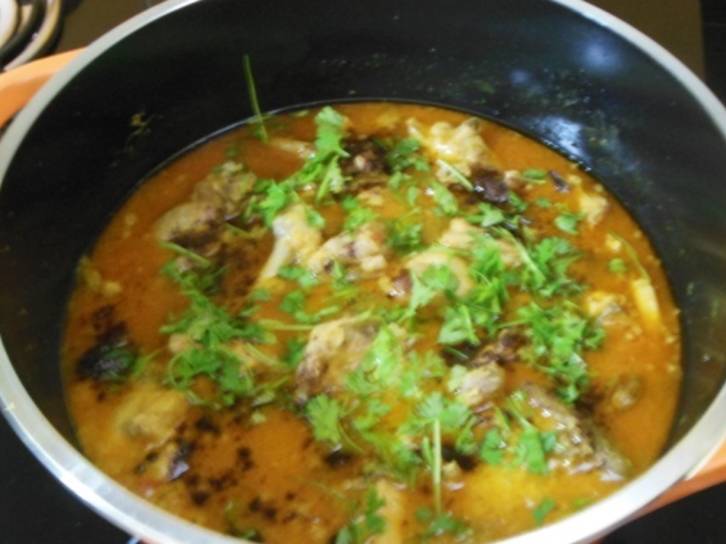
An Interesting Twist To The Chicken Recipe For Winter
1 Dec 2015 | 4 min Read
Shyamlee Mahal
Author | 29 Articles
t the onset of winter season fresh methi leaves (fenugreek) form an integral part of our diet. Methi leaves are a rich reservoir of medicinal properties that imparts many health benefits. Methi is specially good for pregnant ladies and growing children. If added to chicken, it serves as an attractive option to kids who otherwise don’t like green veggies! With each morsel of chicken, an aromatic steam smelling of garlic, fenugreek and warm spices will entice our senses. A healthy and tasty dish for a winter evening!
Ingredient
1. Chicken – 1 kg (preferably with bone)
2. Fenugreek leaves – 1 cup (cleaned and washed)
3. Yoghurt – 1 cup
4. Ghee/Oil – ½ cup
5. Whole Garam Masala
- Green Cardamom – 5
- Black Cardamom – 1
- Cloves – 5
- Cinnamon – 1 inch
- Bay leaf – 1
- Mace – 1 pinch
6. Onions – 1 ¾ Cup Chopped
7. Garlic – 3 tbsp minced
8. Ginger – 5 tbsp minced
9. Green Chilies – 4
10. Turmeric – 1 tsp
11. Coriander powder – 2tsp
12. Kashmiri Chili powder – 1tsp
13. Tomatoes – 1 cup (chopped)
14. Coriander – ¼ cup (chopped)
This is how I did it
1. Immerse methi leaves in salted water for 30 minutes to remove bitterness. If you enjoy the slight bitterness of methi leaves then skip this step.
2. Whisk yoghurt in a large bowl with salt. Add roughly chopped methi leaves to the yoghurt, marinate the chicken with it and set it aside for at least 4 hours.
3. Heat oil in a handi. Add whole garam masala (except tej patta) and sauté over medium heat till the masala begins to crackle.
4. Add onions and sauté till golden brown. When it is almost brown, add tej patta (bay leaves).
5. Add ginger, garlic and green chilies and stir for 2 minutes.
6. Dissolve turmeric powder, coriander powder and red chilies in 1/4th cup of water and then add to the wok. This is done so that the spices do not get burnt while cooking. Traditionally we had the practice of grinding fresh masalas using a pestle and mortar which used to be wet. This acts as the closest substitute. Stir for a minute.
7. Add tomatoes and sauté until the fats from the oil leaves the masala.
8. Add marinated chicken along with the marinade and 3/4th cup of water. Bring it to boil and simmer till chicken is almost cooked and fat leaves the masala.
9. Adjust the seasoning (Add salt to taste).
10. Sprinkle garam masala powder and chopped coriander leaves. Seal the handi with whole wheat dough.
11. Put on dum in the preheated oven at 170 degrees Celsius for 15 minutes.
12. The dish is ready to be served.
When can it be served
It can be served for both lunch and dinner.
Serving Suggestions
Serve it with Indian breads (Roti/ paratha) of your choice and salad.
Tips and Tricks
1. On special occasions, I have tried to make this dish in desi ghee. That adds another flavour to the dish.
2. It goes best with Indian bread of your choice. For change, however it can be served with vegetable Pulao too.
3. If fresh methi leaves are not available, it can be replaced with 2 tbsp kasoori methi. However it should not be added in the marinade. It should be added just before putting the dish on dum.
4. If you want to make for a party or large crowd, prepare the masala and marinade one day before. On the day of the party, just cook the marinated chicken in the masala and put on dum.
5. On opening the handi, an amazing fragrance fills the air. Hence, if possible open the hot handi on the serving table itself. It is sure to leave everyone on the table asking for more!
All pictures in this article are original and have been contributed by the author.
A


Related Topics for you
Suggestions offered by doctors on BabyChakra are of advisory nature i.e., for educational and informational purposes only. Content posted on, created for, or compiled by BabyChakra is not intended or designed to replace your doctor's independent judgment about any symptom, condition, or the appropriateness or risks of a procedure or treatment for a given person.
